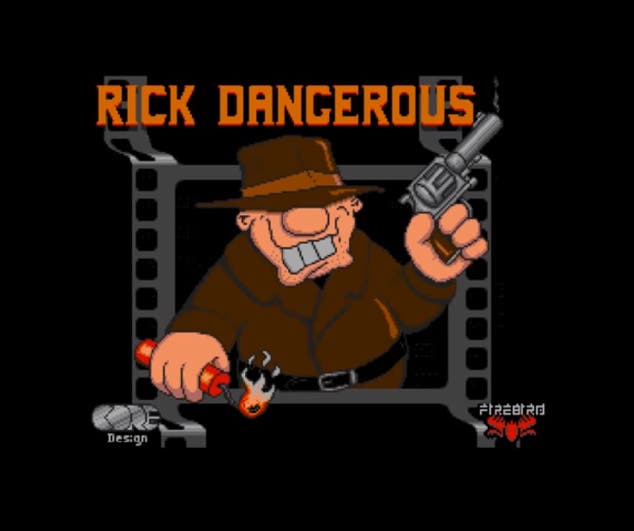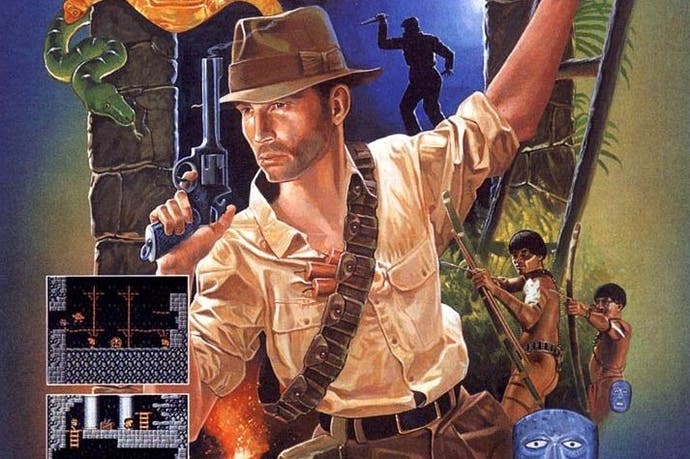Remembering Rick Dangerous, the original tomb raider
Indy gaming.
Rick Dangerous was first released a quarter of a century ago, but as a certain whip-cracking, Nazi-smacking professor of archaeology once said: "It's not the years, it's the mileage." If you were in any doubt as to the inspiration behind the very first game Core Design brought to market - the 2D platform adventures of a square-jawed hero with a fedora, leather jacket and revolver - the opening seconds of actual gameplay hammer home that this is an undisguised tribute to Henry Jones Junior.
Your first steps as Rick trigger the release of a deadly trundling boulder, forcing you to run, fall and dodge deeper into a subterranean jungle temple to escape being flattened. The first local tribesman you encounter is not so lucky - a deliberate design decision, it seems. Every single time, the poor fellow is creamed by the rolling deathtrap, an endlessly repeated introduction to the franchise's signature death move. The neutralised baddie bounces out of the screen in faux-3D, waving his arms with tantrum intensity while yelling "waaaarrghh!" It's like an Early Learning Centre remix of the famous Wilhelm scream.

If you've spent any time at all with Rick Dangerous, it's this sound effect that will bring it all flooding back. At first, the memories will likely be fond ones: here was a game that seemed to combine the best of eccentric 8-bit character and game design with cinematic 16-bit sparkle. (My experience was on the surprisingly well-reviewed Amiga version, and the various 8-bit adaptations mostly scored well with the gaming press.) Rick Dangerous may have borrowed heavily from an existing intellectual property - and it probably didn't hurt that Indiana Jones and the Last Crusade came out in that same golden summer of 1989 - but it gave those elements its own cheeky, cartoonish spin.
The beautifully crafted box artwork may have echoed Drew Struzan's iconic Indy posters, but the in-game sprites followed a very different artistic tradition: that of the classic British comic strip. All the characters are squat, chunky and have their headgear pulled down so far over their heads that all you can see is a toothy grin - Rick himself looks like Bully Beef from The Dandy gleefully cosplaying as Doctor Jones. From the fanfare menu music to the tongue-in-cheek newsreel that introduced each level, it was a game brimming with fun, character and confidence, and made the world of Rick Dangerous seem like a pleasingly fully-realised place.
Unfortunately, that fully-realised world was also a world of pain. If there was a forgivable disconnect between the lovely hand-painted box art and the blockier game assets, there was a downright alarming gulf between the cutesy art direction and the ruthless difficulty level. There are certain titles you can go back to after they've been on a shelf for years, but within minutes of playing, you've reactivated ancient muscle memory and achieved peak flow. Rick Dangerous is not one of those games. It will stop you dead.

The trundling boulder is just the start of it: there are lethal blow-darts triggered by unseen pressure pads, deadly spikes waiting to meet you after leap-of-faith jumps, stone blocks that swipe across the screen without warning and falling grates ready to skewer you. And that's just on the first level.
After that initial exhilarating run to escape the boulder, the rest of the game falls into a rhythm of necessarily cautious mine-sweeping. Faced with a new batch of screens, you inch forward, crawling to avoid any unexpected blow-dart attack, keen to discover what will kill you this time, before filing away that deadly intel so you can advance just a little bit further on your next playthrough. Rather than a swashbuckling romp, Rick Dangerous becomes a memory test that gets longer and harder the more you progress. Pre-empting what's going to kill you isn't even always enough to survive - the game also demands precise platforming skills and thrifty inventory management.
The six lives you start with sounds like a lot, but just one particularly tricky road-bump can see you quickly burn through all of them. Rick similarly has six bullets in his trusty revolver - which, in true Indy style, sounds like a cannon going off - and six sticks of delayed-fuse dynamite with which to remove obstacles. All these resources are finite, although you also have a poking stick that you can use as many times as you like to stun enemies or nudge hanging bats into action. (Presumably giving Rick a bullwhip would have sailed just a little too close to copyright infringement.)
Right now, Dark Souls 2 is a global megahit among masochistic gamers eager to test their mettle against gaming systems that are stacked against them. So you could argue it's the perfect time to bring Rick Dangerous back, to dig up this frustrating, charming relic and reboot it. Officially, the franchise ground to a halt after just two games, with a Flash Gordon-spoofing sequel that swapped out the fedora and revolver for a blond quiff and laser pistol. (The greatest innovation of Rick Dangerous 2 was giving players access to more than one level from the outset, multiplying the amount of environments you could get hopelessly stuck in by a factor of four.)

Core Design, of course, would soon enjoy blockbusting success with another raider of tombs, albeit one of the opposite sex who looked at things from a different perspective. And if Lara has some Dangerous DNA in her, there also seems to be a family resemblance in procedurally generated platformer Spelunky, another game where death is unavoidable, if perhaps a little bit more enjoyable.
But in truth, there's no pressing need to reboot Rick, because there already exists a lovingly crafted Flash version that you can play in your browser. From the rousing intro music to the perfectly pitched "waaaarrghh!", it's a rigorously faithful emulation that feels authentic in all the right ways. And while it won't let you reassign the slightly fiddly keyboard controls, it does include the option of unlimited lives and ammo.
It doesn't make the game a cakewalk but it means that with a bit of patience, it's possible to press on into previously uncharted territory. Back in the day, I could rely on myself to make it as far as the second, Egypt-set level before exhausting my supply of spare Ricks. Now, with the cheat mode enabled, it feels like level three's Schwarzendumpf Castle is only a sustained period of memorisation and judiciously applied platform discipline away. This is my Ark, my Sankara Stone, my Grail.
I'd always assumed Rick's toothy, beaming perma-grin was either an intentional personality point - here was an adventurer who took so much pleasure from putting his life in danger that he couldn't hide his joy even if he wanted to - or, more prosaically, just a byproduct of working within the confines of a 24x21 pixel grid for the character design. It's only 25 years later that a third option occurs to me - that Rick already knows how hard and frustrating things are going to be, and is merely gritting his teeth.

